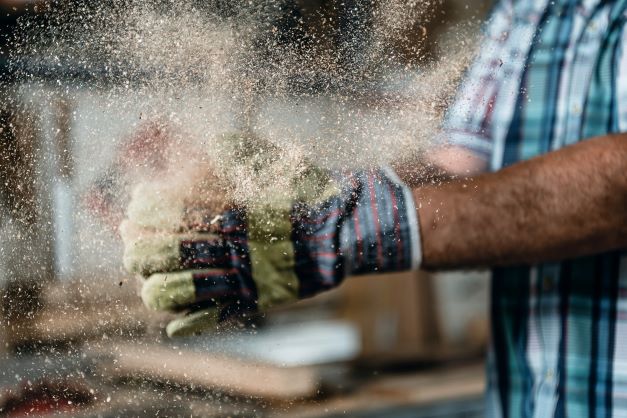
As a carpenter, you’d probably say your most important body part is your hands – after all, they’re tools you use to get the job done every day.
When your hands are your bread and butter, it makes sense to look after them – avoiding cuts and impact injuries, and maybe even attending physio appointments to keep repetitive strains at bay. Carpenters routinely do these things because not doing so could result in them not being able to work, and therefore not being able to earn.
But your hands aren’t the only part of your body that can be put at risk when you work as a carpenter. Exposure to dust and chemicals in the course of your everyday work can put you at risk of damage to an even more critical body part – your lungs.
Respiratory health for woodworkers
Respiratory health is usually thought of as more of a concern for joiners in a workshop, where dust levels and air quality must be carefully managed. But with wood dust exposure racking up over many years, it’s a significant consideration for carpenters right across the industry.
Wood dust is an unavoidable by-product of most joinery or carpentry tasks. It’s generated every time you cut, drill, plane or sand a piece of timber. It’s regarded as a ‘hazardous substance’ governed by the COSHH Regulations, with hardwood dust being regarded as more dangerous than softwood.
Wood dust is dangerous because it can cause serious, non-reversible health problems including dermatitis, irritation to the eyes, nose and throat, asthma, and in rare cases, cancer. As a carpenter or joiner, you’re four times more likely to suffer from asthma than somebody in another occupation (Source: HSE). Experts say this is closely linked to the inhalation of fine wood dust particles, which can penetrate deeply into the lungs, and also the inhalation of mould and fungi spores which are released when timber is cut – especially green or unseasoned wood.
Employer responsibilities
COSHH guidelines are clear on what employers must do to minimise the risks related to wood dust. Most of the regulations pertain to the control and extraction of dust in a workshop setting, including workplace exposure limits (WELs). For carpenters working on a construction site, the same exposure limits apply but the use of extraction systems is not usually practical. In these cases, the use of on-tool extraction systems plus respiratory protective equipment (RPE) is required. Wood dust exposure can also be limited by:
– using wood types known to be less toxic. Some types are more hazardous than others
– ordering pre-cut materials
– using dedicated work areas to minimise the spread of wood dust
– using ‘pre-finished’ materials
Symptoms of wood dust sensitisation
Wood dust inhalation or exposure can cause a range of health symptoms ranging from subtle to severe. Exposure over long periods of time makes you more likely to develop a serious lung condition such as asthma or COPD. In very rare cases, inhalation of hardwood dust over an extended period can cause a specific type of cancer called adenocarcinoma, which affects the lining of the nose and sinuses.
If you work in an environment with significant wood dust and you regularly experience any of the following symptoms, you should consider taking additional steps to protect your health:
– Dry, itchy or watery eyes
– Conjunctivitis
– Coughing, sneezing or wheezing
– Dry or sore throat
– Shortness of breath
– Nasal congestion
– Nosebleeds
Reduce the risks of wood dust inhalation
Your employer has a duty of care to ensure your exposure to wood dust is limited. But as an individual – or if you are self-employed – there are steps you can take to minimise the risks of dust inhalation. These include:
– Ensuring your workspace is well-ventilated
– ALWAYS using the available on-tool extraction and/or RPE available
– Ensuring your RPE is fit-tested for your face
– Not blowing or sweeping settled dust – use vacuum cleanup instead
– Using wet cleanup methods for surfaces
– Bagging and sealing dust waste
– Using self-drilling fixings to avoid dust generation
Find out more about controlling the risks posed by wood dust here. For further information about our range of self-drilling wood fixings, get in touch!


